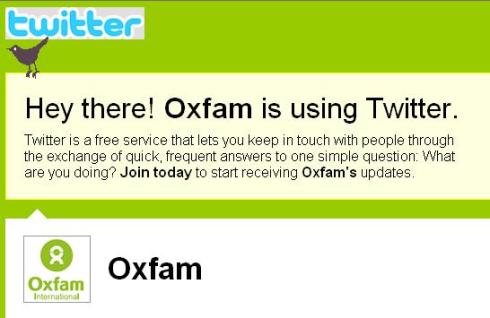Micro-blogging and development…
 We have seen the great potential of real-time micro-blogging – for example a student journalist who used the platform to get out of prison.
We have seen the great potential of real-time micro-blogging – for example a student journalist who used the platform to get out of prison.
But now even NGOs and charities have flown into the ‘tweeting’ nest in a bid to share videos, stories and blogs – and as a way to keep their supporters up to date on the development work they do.
Some people are still wary and critical of this method of communication, with fears that it will totally replace a more conventional method of reporting.
‘Bits of tiny shorthand’
Anna Kramer of Oxfam America says:
And as a nonprofit communicator, I fear that Twitter undermines everything I try to do: Use words. Tell stories. Talk about people… I imagine Oxfam writers coming back from the field in the not too distant future.
To get the word out, we’d tweet about our experiences, crafting bits of tiny shorthand to share with followers. They’d then re-tweet, passing things on, sure, but not really connecting anyone to the heart of our story–the people and organizations we work with on the ground. With space for only 140 characters, I wonder: Where do those voices fit in?
Impersonal?
I understand Kramer’s point. Twitter produces media that is devoid of the ‘human face’ factor and you cannot simplify a humantiarian crisis in 140-characters. But it does give NGOs a human voice that followers can engage and interact with – not forgetting applications like twitpic that can accompany tweets.
It can get over-personal however, as the tweeter’s personal views cannot cloud the NGO’s micro-blogging goal. It also gives them the real-time opportunity to be more transparent in the work they do. What they must not do is use it as a platform to advertise themselves per se.
New audience
Twitter gets the information across without emphasising the element of poverty voyeurism to which people have grown so accustomed, and gradually becoming immune.
NGOs can also open up to audiences always on the move whose concentration spans can only cope with 140-characters and it can help with the branding of an NGO who needs to get a real feel for their audience and who is missing from it. People choose to follow you on Twitter so it’s also not so passive.
If NGOs use the right techniques they can effectively utilise this cost-effective media tool to expand their donor base and maintain awareness over a longer period of time than you would get with a 2-minute television ad. And then there are celebrities, with whom Twitter is a big hit – if you get them retweeting your updates, you have the potential of a massive audience.
Take a look for yourself at at how these organisations are using Twitter:
You can also read an interesting report on global activism and new media here.

Leave a comment